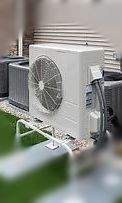Become a Profitable HVAC Company

A Comprehensive Guide to Growing a Successful HVAC Company
Introduction:
Starting and growing an HVAC company can be a lucrative venture, especially with the increasing demand for climate control services. However, it requires strategic planning, dedication, and continuous effort. This comprehensive guide aims to provide a step-by-step roadmap for aspiring entrepreneurs looking to establish and expand a successful HVAC business.
Step 1: Market Research and Planning
Before diving into the HVAC business, conduct thorough market research to understand the demand, competition, and industry trends in your area. Identify your target market, such as residential, commercial, or industrial clients, and assess their needs.
Identify Your Niche: Determine if you want to specialize in residential installations, commercial maintenance, or industrial HVAC solutions. Identifying your niche in the HVAC business is a crucial step towards establishing a competitive edge and targeting your services to specific market segments. Here's a detailed exploration of how to identify and capitalize on your niche:
1. Evaluate Your Expertise: Begin by assessing your skills, experience, and resources within the HVAC industry. Determine what aspects of HVAC work you excel at or have a particular interest in. This could be anything from installation and maintenance to specialized services like ductwork design, indoor air quality solutions, or energy-efficient upgrades.
2. Analyze Market Demand: Research the local market to identify areas with high demand and untapped opportunities. Consider factors such as demographics, climate, industry trends, and emerging technologies. Look for gaps or underserved segments where your expertise and services can fulfill specific needs or pain points.
3. Assess Competitor Landscape: Study your competitors to understand their strengths, weaknesses, and the services they offer. Identify areas where you can differentiate yourself and provide unique value to customers. Look for niches that are not adequately addressed or areas where you can offer superior quality, faster response times, or specialized expertise.
4. Consider Target Customer Base: Determine the type of customers you want to serve, whether it's residential, commercial, or industrial clients. Each segment has its own set of needs and requirements, so tailor your niche accordingly. For example, you might specialize in high-end residential HVAC installations, commercial HVAC maintenance contracts, or industrial refrigeration systems.
5. Evaluate Profitability: Assess the profitability of potential niches by estimating the demand, pricing dynamics, and profitability margins. Consider factors such as the initial investment required, recurring revenue opportunities, and long-term growth potential. Choose a niche that not only aligns with your expertise and interests but also offers sustainable profitability and growth prospects.
6. Focus on Unique Selling Proposition (USP): Define your unique selling proposition that sets you apart from competitors and resonates with your target market. This could be exceptional customer service, specialized expertise, innovative solutions, or a commitment to sustainability. Communicate your USP clearly in your marketing materials and branding to attract customers who value what you offer.
7. Adaptability and Flexibility: Stay adaptable and open to evolving market trends, customer preferences, and industry innovations. Your chosen niche may evolve over time as new technologies emerge or customer needs change. Be prepared to adjust your strategy and offerings accordingly to stay relevant and competitive in the market.
8. Key Performance Indicators: Business owners can effectively track Key Performance Indicators (KPIs) and progress toward revenue goals by establishing both daily and monthly routines. On a daily basis, business owners can benefit from creating a simple report that highlights key metrics such as the number of calls made, revenue generated, and their progress toward monthly targets. This allows them to have a real-time understanding of their performance and make immediate adjustments as needed. Furthermore, at the end of each month, business owners should conduct a thorough financial review with their bookkeeper or accountant, and later involve their leadership team. This monthly review is essential in gaining complete clarity on how the business has performed relative to its revenue goals. By analyzing these monthly results, owners can identify trends, areas of improvement, and make any necessary adjustments to ensure they stay on track to achieve their year-end target. Regular monitoring and review of KPIs on both a daily and monthly basis empower business owners to make informed decisions and adapt strategies to meet their financial objectives.
8.1 Ongoing tracking of Key Performance Indicators (KPIs) plays a crucial role in effectively pacing towards profit targets. By regularly monitoring and analyzing KPIs, businesses can gain valuable insights into their performance and progress towards revenue and profit goals. This systematic approach involves setting clear revenue and profit targets, establishing specific KPIs aligned with these objectives, and continuously tracking and evaluating performance against these metrics. Through diligent KPI tracking, businesses can identify trends, areas of improvement, and potential issues that may impact their ability to achieve sales, gross profit, and net profit goals. By regularly reviewing KPI data for each department, businesses can make informed decisions, adjust strategies as needed, and stay on course towards reaching their profit targets. In essence, ongoing tracking of KPIs provides businesses with the visibility and control necessary to effectively manage their performance and ensure alignment with their financial objectives.
Examples of HVAC Niches:
1. Geographical Specialization: Focus on serving specific geographical areas with unique climate challenges, such as coastal regions prone to salt corrosion or mountainous areas with extreme temperature variations.
2. Green HVAC Solutions: Specialize in energy-efficient HVAC systems, renewable energy integration, and sustainable building practices to appeal to environmentally conscious customers and meet green building regulations.
3. Indoor Air Quality (IAQ): Offer specialized IAQ assessments, air purification systems, ventilation solutions, and mold remediation services to improve indoor air quality and address health concerns such as allergies and respiratory issues.
4. Smart Home Automation: Provide smart HVAC systems integrated with home automation platforms for remote monitoring, energy management, and personalized comfort control. Target tech-savvy homeowners looking for convenience and energy savings.
5. Historic Building Restoration: Focus on HVAC solutions for historic buildings, museums, and heritage sites, where preserving architectural integrity and maintaining climate control are critical considerations.
6. HVAC Retrofitting and Upgrades: Specialize in upgrading outdated HVAC systems with modern, energy-efficient equipment, retrofitting existing buildings for improved performance and cost savings.
7. 24/7 Emergency Services: Cater to customers who require round-the-clock HVAC repair and maintenance services, such as hospitals, data centers, and critical infrastructure facilities.
Ultimately, identifying your niche in the HVAC business involves finding a balance between your expertise, market demand, profitability, and unique value proposition. By specializing in a specific area of HVAC services, you can differentiate your business, attract your ideal customers, and position yourself for long-term success and growth.
Step 2: Obtain Necessary Licenses and Certifications
Operating an HVAC business requires obtaining the appropriate licenses and certifications to ensure compliance with industry regulations and standards. I'll keep this short because you've most likely received your licensing & certifications.
2.1 Licensing: Check with your state and local authorities to determine the specific licensing requirements for HVAC contractors in your area. Obtain the necessary licenses and permits to legally operate your business.
2.2 Certifications: Consider obtaining certifications from reputable organizations such as North American Technician Excellence (NATE) or the Environmental Protection Agency (EPA 608). These certifications can enhance your credibility and demonstrate your expertise to potential customers.
Step 3: Invest in Quality Equipment and Training
The success of an HVAC business relies heavily on the quality of equipment and the expertise of its technicians. Invest in reliable tools, equipment, and ongoing training for your staff to ensure efficient and high-quality service delivery.
3.1 Equipment: Purchase high-quality HVAC equipment from reputable suppliers to ensure reliability and durability. Invest in tools for installation, maintenance, and repair jobs to meet the diverse needs of your customers.
***Keep in mind that some manufacturers have dealer programs for contractors like Fujitsu, Mitsubishi, LG, Ruud, & Comfort Aire. Dealer programs offer benefits based off prerequisites like annual sales and training. Some sell directly to contractors like Lennox & Carrier, and do not sell to distributors/supply houses, and some sell directly to consumers like Mr. Cool.
3.2 Training: Provide comprehensive training programs for your technicians to keep them updated on the latest industry trends, technologies, and best practices. Encourage continuous learning and certification to maintain a skilled workforce capable of handling various HVAC systems. Today, there are various ways to get trainings. Interplay VR is a virtual reality based training program for HVAC technicians and it works with the Oculus. Most equipment manufacturers have their own trainings in person and online as well. There is no shortage of trainings, so make sure to stay ahead of the new technology.
Step 4: Establish Strong Customer Relationships
Building and maintaining strong relationships with customers is essential for the long-term success of your HVAC business. Focus on delivering exceptional service and prioritize customer satisfaction to foster loyalty and generate repeat business. A satisfied customer is your best type of marketing.
4.1 Responsive Communication: Ensure prompt and responsive communication with customers, whether it's answering inquiries, scheduling appointments, or addressing service issues. Establish multiple communication channels such as phone, email, and online chat to accommodate diverse customer preferences. Even if you're not interested in a job or are too busy, ALWAYS call the customer back. I cannot stress that enough, ALWAYS call the customer back!
4.2 Transparent Pricing: Be transparent about your pricing structure and provide detailed estimates upfront to avoid misunderstandings or disputes later on. Offer competitive pricing while emphasizing the value of your services to justify the cost to customers. You do not have to give an itemized invoice but you should give a detailed one. Make sure to write down what they are getting for the cost.
4.3 Follow-Up and Feedback: Follow up with customers after service visits to ensure their satisfaction and address any concerns or feedback they may have. Implement a feedback system to gather insights and continuously improve your services based on customer input. Going the extra mile with follow-up calls after service and installations is what will separate you from your competition. This is a worthwhile time investment.
4.4 Customer Service Representative Manager: A Customer Service Representative (CSR) manager should focus on various specific daily metrics to effectively track performance. Some key numbers to analyze include call booking rates, the quantity of outbound calls made, the volume of inbound calls received, and other detailed data points that provide insights into the team's productivity and customer interaction. By thoroughly monitoring these metrics on a daily basis, CSR managers can gain a comprehensive overview of their team's performance and identify areas for improvement to enhance overall customer service operations.
Step 5: Implement Effective Marketing Strategies
Marketing plays a crucial role in attracting new customers and expanding your HVAC business. Develop a strategic marketing plan to raise awareness, generate leads, and differentiate your brand from competitors. The 3 following types of marketing are in order of importance. It is most important to get your website and Google SEO done first as this is where the large majority of customers will come from.
5.1 Online Presence: Create a professional website showcasing your services, expertise, testimonials, and contact information. Optimize your website for search engines (SEO) to improve visibility and attract organic traffic from potential customers searching for HVAC services online. If you can swing it, its worthwhile to hire an expert to build you a professional website with great SEO. Most customers will find their home services company online, specifically on Google. Most customers search Google to find an HVAC contractor to install or repair their systems.
5.2 Social Media Marketing: Leverage social media platforms such as Facebook, Instagram, and LinkedIn to engage with your target audience, share informative content, and showcase your projects. Use targeted advertising to reach specific demographics and geographical areas.
5.3 Local Advertising: Invest in local advertising channels such as print ads, direct mailers, billboards and community sponsorships to reach potential customers in your service area. Participate in home and trade shows to showcase your services and network with potential clients.
Step 6: Focus on Operational Efficiency and Growth
To sustain and grow your HVAC business, focus on optimizing operational efficiency, streamlining processes, and seizing opportunities for expansion. In todays world of technology, its never been easier to streamline and automate business operations.
6.0 Tracking Technician Efficiency: Tracking efficiency rates of technicians can significantly improve overall profit margins by providing valuable insights into the productivity and performance of each job performed. By monitoring factors such as drive time and on-premises billable time, companies can assess how efficiently their technicians are completing tasks. This data allows businesses to identify areas where improvements can be made to streamline processes, reduce inefficiencies, and maximize billable hours. By using field service software, companies can easily track and analyze the efficiency of each job. For instance, calculating the difference between the allotted time for a task and the actual time taken to complete it provides a clear measure of efficiency. This information helps businesses understand how well their technicians are utilizing their time and resources, ultimately impacting the profitability of each job. Moreover, by consistently monitoring and evaluating job efficiency rates, companies can establish benchmarks for performance and set targets for improvement. By aiming for a specific efficiency range, such as 95% to 105%, technicians are motivated to work more effectively and complete tasks within the allocated time frames. This not only boosts productivity but also ensures that jobs are completed profitably. Track data using software like Jobber. This data enables informed decision-making by highlighting which jobs were profitable and which were not. By analyzing these insights, companies can adjust allocated times, optimize pricing strategies, and make informed adjustments to maximize profitability. Overall, tracking efficiency rates of technicians provides businesses with actionable data to enhance operational performance, identify areas for improvement, and ultimately increase profit margins. By leveraging technology and data-driven insights, companies can take proactive steps to boost efficiency, enhance customer satisfaction, and achieve sustainable growth.
6.1 Efficient Scheduling: Implement efficient scheduling software to manage appointments, dispatch technicians, and optimize routes for service calls. Minimize downtime and maximize productivity by effectively allocating resources and minimizing travel time between jobs.
6.2 Expand Service Offerings: Diversify your service offerings to meet the evolving needs of your customers and capitalize on new opportunities in the market. Consider expanding into related areas such as indoor air quality solutions, energy-efficient upgrades, or smart home automation.
6.3 Invest in Technology: Embrace technology to streamline operations, improve service delivery, and enhance customer experience. Utilize HVAC software for inventory management, invoicing, and customer relationship management (CRM) to improve efficiency and accuracy.
Examples of great software: Service Titan, Housecall Pro, Field Edge, Jobber, Honeybook, Vcita, and many, many more. It isn't so much about which is best, but more about which is best for you. Each will have Pros and Cons depending on what is most important to you and your business.
Achieving a high level of optimizing efficiency in HVAC businesses involves a focus on implementing best practices and empowering your team to achieve maximum performance. This tier goes beyond just setting goals and tracking progress by delving into strategies that enhance operational efficiency and drive profitability. By optimizing for efficiency and implementing best practices, HVAC businesses can streamline their operations, reduce waste, and increase productivity. This can lead to cost savings, improved customer satisfaction, and ultimately, higher profit margins. When you empower your team to excel and perform at their best, you harness their skills and talents to drive the business forward. Implementing best practices in areas such as scheduling, inventory management, and service delivery can result in smoother operations, faster turnaround times, and reduced errors. This not only improves the overall customer experience but also helps the business operate more effectively and profitably. ServiceTitan, for example, offers tools and resources that enable HVAC businesses to optimize their operations, track key metrics, and implement industry best practices. By leveraging these tools and focusing on efficiency and best practices, HVAC businesses can create a solid foundation for exceeding profit goals and achieving sustainable growth.
Step 7: Prioritize Employee Development and Satisfaction
Your employees are the backbone of your HVAC business, and their satisfaction and development are critical for long-term success. Invest in training, professional development, and a positive work culture to attract and retain top talent. Don't fall into the trap of thinking you are doing employees a favor by hiring them. Your team is the face and the heart of your organization. One of the greatest quotes for a leader is, "A leader eats last." Remember that and you will have a much better chance at keeping and hiring top talent. Your team is what will ultimately be the reason you become successful or not.
7.1 Training and Development: Provide ongoing training and professional development opportunities to empower your employees and enhance their skills and knowledge. Encourage certifications and continuing education to keep your team at the forefront of industry advancements.
7.2 Employee Recognition: Recognize and reward employee achievements and contributions to foster a culture of appreciation and motivation. Implement incentive programs, employee perks, and team-building activities to boost morale and job satisfaction.
7.3 Work-Life Balance: Prioritize work-life balance and employee well-being to prevent burnout and maintain productivity and morale. Offer flexible schedules, remote work options, and wellness initiatives to support your team's physical and mental health.
7.4 Payroll and Benefit Packages: While not the most important reason for hiring and keeping top talent, it has a large impact. Make sure you're paying competitive wages to your employees. If they can't survive on their pay, they will be worried about money during work instead of focusing on your business. Not only that, but you will eventually lose them to a company that pays them what they are worth. Stay on top of salaries in your area to make sure you're not lowballing them.
Step 8: Business Finances
8.0 What are the definitions and differences between gross profit, gross profit margin, net profit, and net profit margin: The definitions and distinctions between gross profit, gross profit margin, net profit, and net profit margin are vital aspects of understanding a business's financial performance.
Gross Profit is calculated by deducting all material and labor expenses directly related to the production and delivery of goods and services from total revenue, excluding sales, general, and administrative costs. This figure helps demonstrate the business's ability to cover operational expenses, with a higher gross margin indicating healthier cash flow for potential growth and expansion.
Gross Profit Margin, on the other hand, is the ratio of gross profit to net sales, typically represented as a percentage. It is a key metric for evaluating a company's efficiency in generating profit, with industry benchmarks serving as guidelines for performance.
Net Profit, also referred to as net income, this figure is derived by subtracting all expenses from gross revenues. This includes not only the cost of goods sold but also other operational expenses such as sales, general, and administrative costs, interest expenses, taxes, and other income streams.
Net Profit Margin is the ratio of net income to gross revenues, and like gross profit margin, is expressed as a percentage. A higher net profit margin signifies that the company is efficiently managing its costs and is able to translate a larger portion of its revenue into profit. By maintaining solid gross margins and effectively controlling costs, a company can aim to achieve a net profit margin that surpasses industry averages.
In summary, understanding and monitoring gross profit, gross profit margin, net profit, and net profit margin are crucial for evaluating a business's financial health, operational efficiency, and overall profitability. Achieving healthy profit margins requires careful management of costs, strategic decision-making, and a focus on optimizing revenue streams.
8.1 Obtaining the necessary data for assessing revenue and profit margins, as well as setting goals, involves capturing and recording data consistently throughout the year. The source of this data can vary depending on the tools used in the business. If your business relies on spreadsheets or multiple software solutions for different functions such as call booking, estimating, invoicing, inventory, and accounting, consolidating data from these disparate sources can be challenging and time-consuming. In contrast, businesses utilizing field service software like ServiceTitan have a more streamlined process. These software solutions centralize operational data into a single platform, offering robust dashboard and reporting tools. With such software, accessing key performance indicators (KPIs) like total revenue, total sales, and other important metrics becomes almost instantaneous. This centralized approach not only simplifies the analysis of revenue and profit margins but also facilitates goal-setting and ongoing tracking of KPIs by providing a consolidated view of all operational data in one place.
8.2 Three Tiered Process for Improving Profit Margins: A three-tiered process for enhancing HVAC profit margins involves the following steps:
1. Tier 1: Assessing Current Revenue and Setting Improvement Goals - Evaluate the existing revenue and profit margins. - Establish goals to enhance financial performance. - Conduct annual planning to review past business performance and set targets for the future. - Analyze high-level Key Performance Indicators (KPIs) by department. - Define revenue goals per month for each department and determine percentage increases. - Calculate lead requirements to achieve revenue and profit objectives.
2. Tier 2: Continuous Monitoring of KPIs and Progress Towards Profit Goals - Commence ongoing monitoring of KPIs to track performance. - Gauge progress towards sales, gross profit, and net profit targets.
3. Tier 3: Optimizing Efficiency and Empowering the Team - Implement best practices to enhance operational efficiency. - Empower your team to function at peak performance levels. By following this structured three-tiered approach, HVAC contractors can effectively enhance their profit margins through strategic planning, continuous monitoring, and optimization of operational practices.
8.3 What is an Acceptable Profit Margin for an HVAC Company: An acceptable gross profit margin for an HVAC business typically falls within the range of 40% to 60% for material. This margin, as advised by industry expert Ken Decker, is crucial for achieving a desirable net profit margin of 14% to 25%. It's essential for HVAC businesses to maintain this level of gross profit margin across all their services, including HVAC installation, service and repair, maintenance, new construction, and other departments. This approach ensures a comprehensive assessment of the business's overall performance, highlighting the significance of both gross profit margins within departments and net profit margins across the entirety of the business. You need at least 10% net profit just to keep up with inflation and rising prices.
8.4 Profit Margin Considerations: The passage highlights the importance of understanding how profit margins can vary across different departments within a service business, particularly in the context of growth and expansion plans. It points out that overhead differences exist in the types of work performed by technicians, with installation and replacement work being more efficient compared to service work. The efficiency of installation work is attributed to factors such as technicians spending extended periods at a single customer location, resulting in reduced travel and administrative tasks. The passage emphasizes the significance of accurately knowing the costs associated with each type of technician work in order to make precise forecasts and improve overall efficiency. It also underscores the critical role of labor costs, which are often the largest expense for HVAC and field service businesses, highlighting the importance of hiring the right personnel to ensure profitability. Ultimately, the passage suggests that without a clear understanding of departmental variations in profit margins, businesses may unknowingly be losing money in certain areas while making profits in others.
8.5 How does understanding and controlling labor costs impact the profitability of service businesses: Understanding and controlling labor costs play a crucial role in determining the profitability of service businesses. Labor expenses typically represent a significant portion of the total costs for many service companies, such as those in the HVAC industry. In order to maximize profit margins, it is essential for businesses to have a clear understanding of their labor costs and how they impact overall profitability. Knowing the actual costs associated with labor is vital when setting prices for services. Without a comprehensive understanding of labor expenses, it can be challenging to establish prices that will generate a profitable return. By accurately tracking labor costs, businesses can make informed decisions about pricing strategies to ensure that revenue covers expenses and yields a satisfactory profit. Furthermore, controlling labor costs involves optimizing technician efficiency. Technicians may not be generating revenue for every hour they work due to various non-billable activities such as travel time, paperwork, and restocking. By calculating and improving technician efficiency rates, businesses can increase billable hours and reduce overhead expenses. This optimization can lead to significant improvements in profit margins without the need to raise prices or acquire new customers. Ultimately, by understanding and effectively managing labor costs, service businesses can enhance profitability by reducing expenses, increasing revenue, or a combination of both. Improving overall efficiency and controlling labor costs are key strategies for service businesses to achieve sustainable growth and financial success.
Conclusion:
Growing a successful HVAC company requires careful planning, dedication, and a customer-centric approach. By following the step-by-step roadmap outlined in this guide and staying adaptable to industry changes and customer needs, you can build a thriving HVAC business that delivers exceptional service and drives sustainable growth in the long run.
HVAC businesses can benefit significantly from the articles, guides and consulting services provided by K. Decker Associates on various aspects of their operations. These resources offer valuable insights and strategies for improving margins, streamlining sales processes, managing service agreements effectively, and enhancing marketing strategies. By utilizing these materials, HVAC businesses can gain a deeper understanding of how to price their services appropriately to maximize profitability, refine their sales processes to convert more leads and increase sales, optimize service agreement programs for consistent cash flow, and implement effective marketing strategies to attract and retain customers. K. Decker Associates resources provide practical tips and best practices tailored to the HVAC industry, enabling businesses to stay competitive and grow their operations. From understanding pricing strategies to enhancing service offerings, these articles and guides offer actionable advice that can help HVAC companies elevate their performance and achieve sustainable growth. By leveraging K. Decker Associates expertise and resources, HVAC businesses can enhance their overall business operations, boost margins, increase sales, and establish a strong market presence in the industry.
HVAC ARTICLES

Our Service Area
Sullivan County, NY
Orange County, NY
Ulster County, NY
Dutchess County, NY
K. Decker Associates LLC.
3432 NY-55 White Lake, NY 12786









